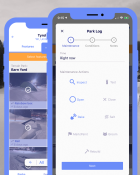I'm trying to do some research for my app, but I've never worked park crew so I could use some help from people that have.
Some people on park crews have told me that they enter their setups into software like 1Risk or 1Park. Others have said that all they have to do is initial a clipboard when they do a rake lap. I’ve also seen park crew take a bunch of measurements of jumps after someone gets injured.
My question is- What's the norm? What does your park do? And more specifically, what information gets recorded and why? Is it for insurance/liability purposes or planning purposes? Does just the presence of features get recorded or certain measurements?
Some people on park crews have told me that they enter their setups into software like 1Risk or 1Park. Others have said that all they have to do is initial a clipboard when they do a rake lap. I’ve also seen park crew take a bunch of measurements of jumps after someone gets injured.
My question is- What's the norm? What does your park do? And more specifically, what information gets recorded and why? Is it for insurance/liability purposes or planning purposes? Does just the presence of features get recorded or certain measurements?
